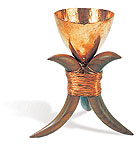Like most bold, new ideas, this one had its early pessimists. “In 1993, during a recession, it seemed like a wacky idea,” says Mike McGee, an alumnus and professor of art, director of the campus' Main Gallery and Grand Central's project facilitator. “We wanted to do something that was unique in the country, combining residential, educational and commercial components into one building in a downtown area.”
As project administrator for Grand Central during the planning and construction phase, McGee conversed frequently with Jay Bond, associate vice president of facilities management, to synthesize ideas contributed by art and theater faculty, and representatives of University Extended Education and the physical plant department.
Project planners recognized that the center would need to become financially self-sustaining. They created a framework so that Grand Central generates income from gallery sales, and the rent collected from the apartment-dwelling students and such private businesses as the Gypsy Den, with its vegetarian cuisine, belly dancers and poetry readings, and the Watermark Printmaking Studio, where alumnus James Lorigan “pulls” prints of fine art.
The results of this team effort were unveiled in February 1999, when the Grand Central — emblematic of optimism and renewal as neighboring structures awaited reclamation — was dedicated during a balloon-festooned event.
Before a crowd of well-wishers, President Milton A. Gordon lauded the partnership between Santa Ana and the university, and then nodding toward the building's first occupants, said, “Representing a range of disciplines from painting to graphic design to sculpture, the founding residents are to be recognized for their pioneering spirit and vision of the potential of this unique living/learning art environment.”
|
|

